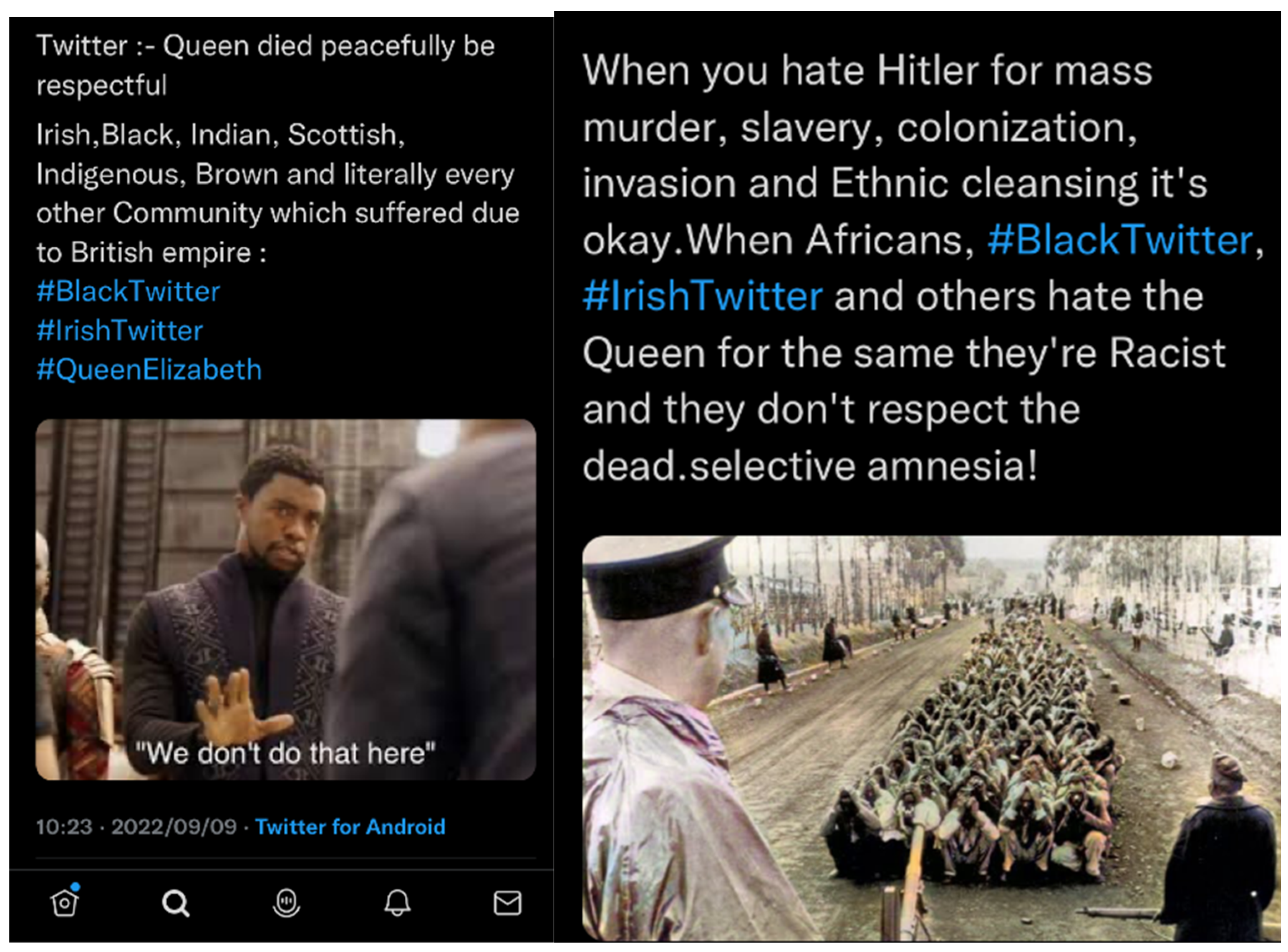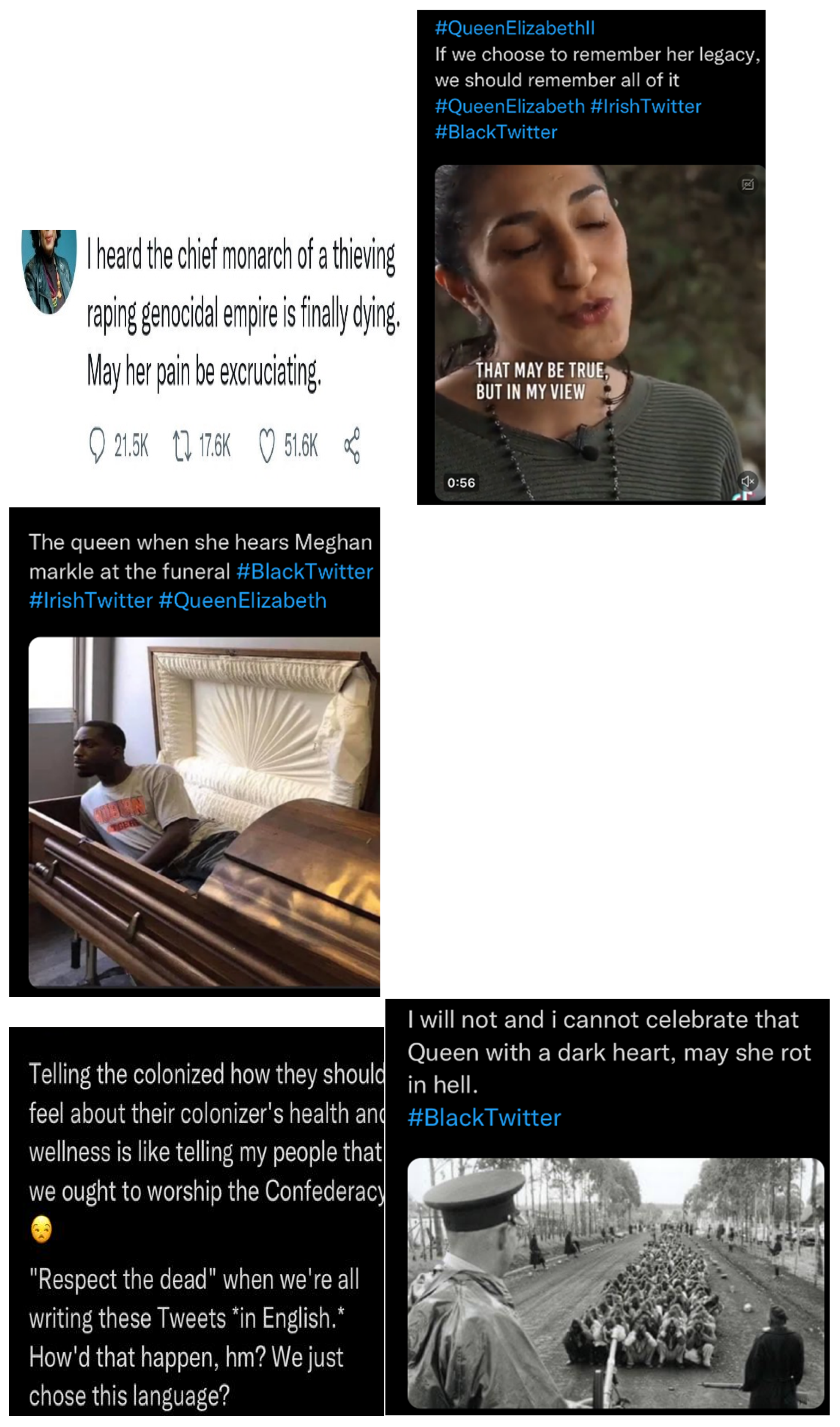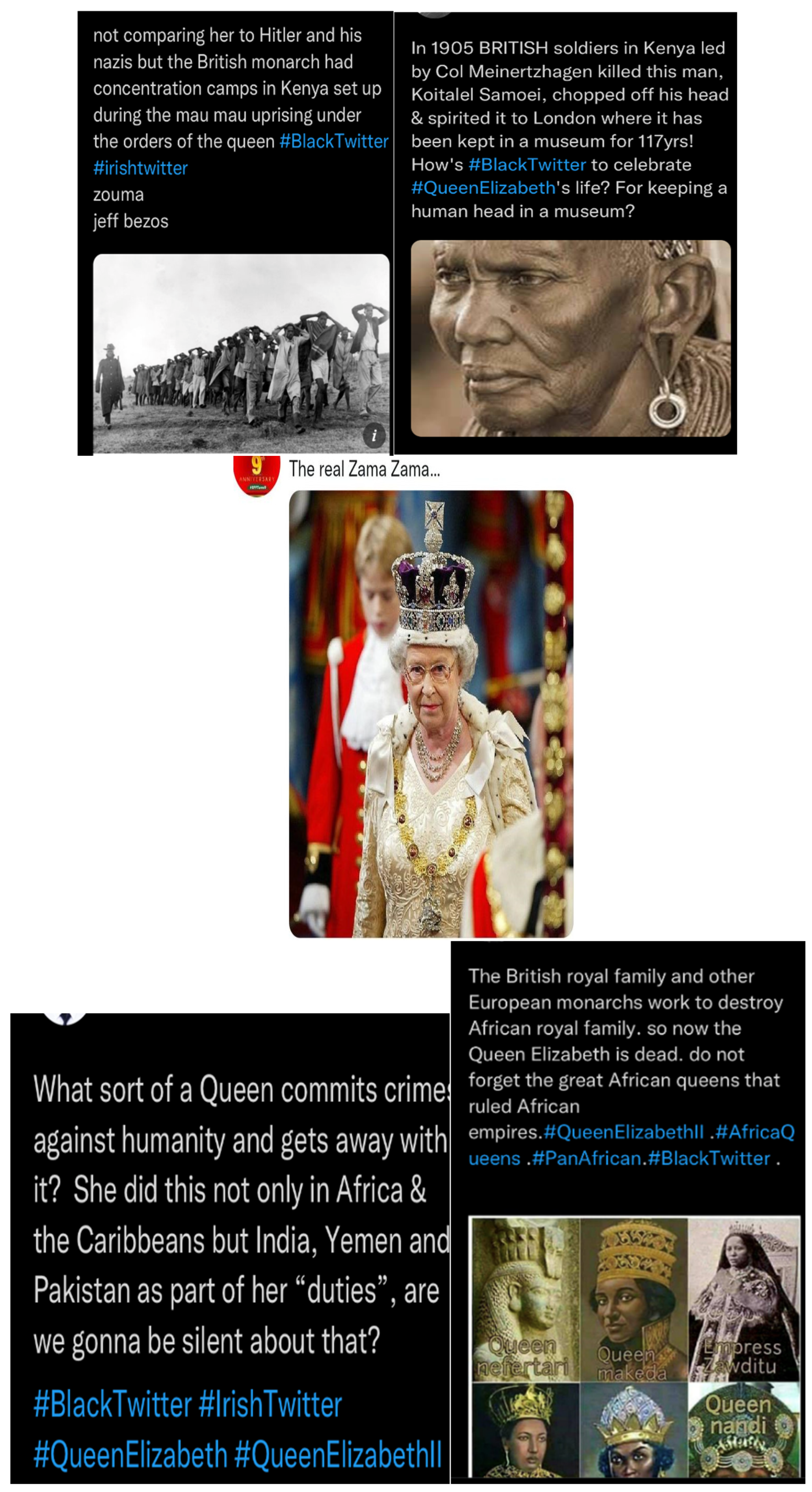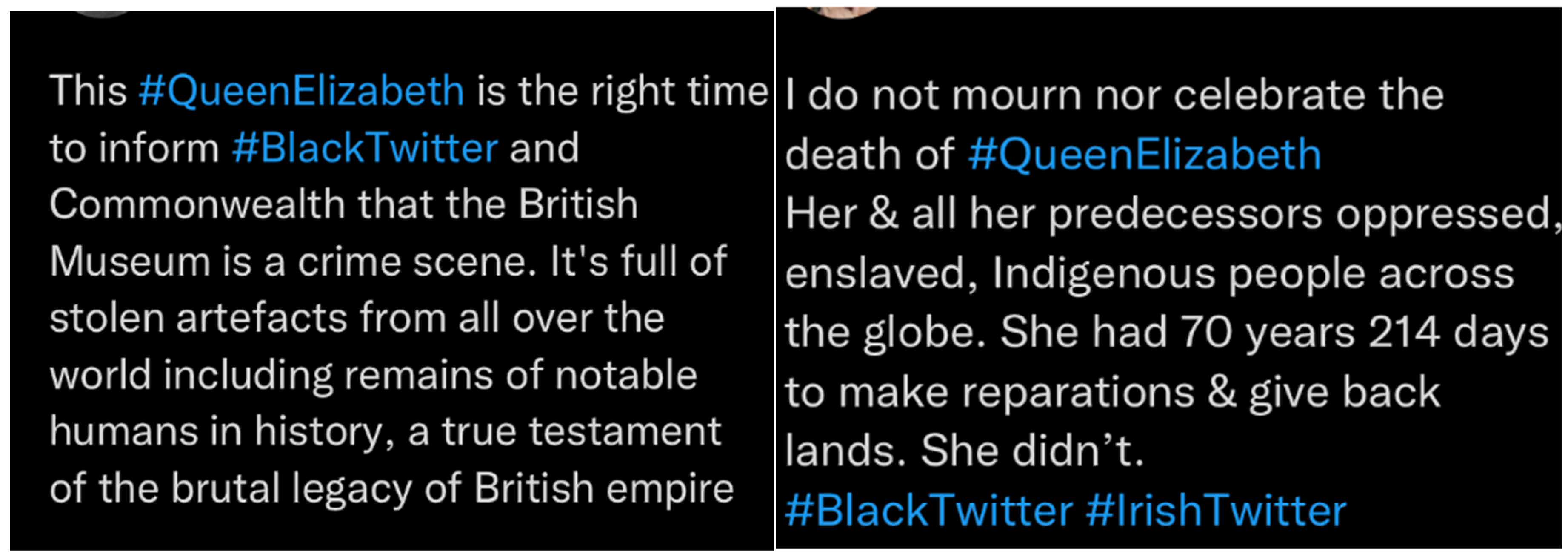“The Queen Is Dead”: Black Twitter’s Global Response to Queen Elizabeth’s Death
Abstract
1. Introduction
2. Black Twitter
3. Social Media and Digital Counterpublics
4. Research Questions
- How did Black Twitter users respond to the news of Queen Elizabeth’s death, and what were the most common themes and sentiments expressed?
- What role did Black Twitter play in shaping the public discourse around Queen Elizabeth’s legacy?
- To what extent did the global reach of Black Twitter contribute to a broader conversation about the role of the British monarchy in contemporary society, and what implications might this have for future discussions of race, power, and representation?
5. Methodology
6. Findings
6.1. Resisting Respectability Politics
6.2. Resisting the Erasure of Black History in Britain and Beyond
6.3. Educating Black People About Their History
7. Conclusions
Funding
Institutional Review Board Statement
Informed Consent Statement
Data Availability Statement
Conflicts of Interest
References
- Abdalla, M. I. (2023). “My Islam be Black”: Resisting erasure, silence, and marginality at the intersection of race and religion. Communication, Culture, and Critique, 16, 9–16. [Google Scholar] [CrossRef]
- Aggarwal, M., Abbasi, H., Arkin, D., & Siemaszko, C. (2022). The queen was not a gentle figurehead in Britain’s former colonies. Available online: https://www.nbcnews.com/news/world/queen-elizabeth-dies-colonies-empire-britain-uk-india-kenya-rcna47250 (accessed on 9 November 2023).
- Aiseng, K. (2024). Black Twitter and digital countepublics in South Africa. Studies in Media and Communication, 12(2), 302–320. [Google Scholar] [CrossRef]
- Akpojivi, U. (2023). Social movements and digital activism in Africa. Springer. [Google Scholar] [CrossRef]
- Al Jazeera. (2022). Queen Elizabeth remembered in Ireland for historic reconciliation. Available online: https://www.aljazeera.com/news/2022/9/9/queen-elizabeth-remembered-in-ireland-for-historic-reconciliation (accessed on 15 March 2023).
- Allahar, A. (2005). Review of Identity and erasure: Finding the Elusive Caribbean, by Sandra Pouchet Paquet, Gert Oostindie, Inge Klinkers, Ian I. Smart, and Kimani S. K. Nehusi. Revista Europea de Estudios Latinoamericanos y Del Caribe/European Review of Latin American and Caribbean Studies, (79), 125–134. [Google Scholar] [CrossRef]
- Appadurai, A. (1990). Disjuncture and difference in th global cultural economy. Theory, Culture, and Society, 7(2–3), 295–310. [Google Scholar] [CrossRef]
- Arab News. (2022). In Yemen: Queen’s death recalls memories of colonial past. Available online: https://www.arabnews.com/node/2164546/middle-east (accessed on 15 March 2023).
- Benkler, Y. (2007). The wealth of networks: How social production transforms markets and freedom. Yale University Press. [Google Scholar]
- Bhatia, S., & Priya, K. R. (2021). Coloniality and psychology: From silencing to re-centering marginalized voices in postcolonial times. Review of General Psychology, 25(4), 422–436. [Google Scholar] [CrossRef]
- Brock, A. (2012). From the blackhand side: Twitter as a cultural conversation. Journal of Broadcasting and Electronic Media, 56(4), 529–549. [Google Scholar] [CrossRef]
- Brock, A. (2020). Distributed blackness: African American cybercultures. New York University Press. [Google Scholar] [CrossRef]
- Brown, S. M. (2022). Queen Elizabeth’s legacy through the lens of colonialism and black lives. Available online: https://www.washingtoninformer.com/queen-elizabeths-legacy-through-the-lens-of-colonialism-and-black-lives/ (accessed on 15 March 2023).
- Busari, S. (2022). Cloud of colonialism hangs over Queen Elizabeth’s legacy in Africa. Available online: https://edition.cnn.com/2022/09/10/africa/colonialism-africa-queen-elizabeth-intl/index.html (accessed on 15 March 2023).
- Carlson, B., & Frazer, R. (2020). “They got filters”: Indigenous social media, the settler gaze, and a politics of hope. Social Media and Society, 6(2), 1–11. [Google Scholar] [CrossRef]
- Castells, M. (2012). Networks of outrage and hope. Polity Press. [Google Scholar]
- Castor, N. F. (2022). Ifa/Orisha digital counterpublics. The Black Scholar, 52(3), 17–29. [Google Scholar] [CrossRef]
- Childs, K. M. (2022). ‘The shade of it all’: How Black women use Instagram and YouTube to contest colorism in the beauty industry. Social Media + Society, 8(2), 1–15. [Google Scholar] [CrossRef]
- Choi, S. Y., & Cho, Y. (2017). Generating counter-public spheres through social media: Two social movements in neoliberalised South Korea. Javnost, 24(1), 15–33. [Google Scholar] [CrossRef]
- Daniels, J. (2013). Race and racism in Internet Studies: A review and critique. New Media and Society, 15(5), 695–717. [Google Scholar] [CrossRef]
- Dazey, M. (2021). Rethinking respectability politics. The British Journal of Sociology, 72(3), 580–593. [Google Scholar] [CrossRef]
- Downey, J., & Fenton, N. (2003). New media, counter publicity, and the public sphere. New Media and Society, 5(2), 185–202. [Google Scholar] [CrossRef]
- Everett, A. (Ed.). (2007). Introduction. In Learning race and ethnicity: Youth and digital media (pp. 1–14). MIT Press. [Google Scholar]
- Farzan, Y. (2022). What will happen next for Black Twitter? Available online: https://www.theguardian.com/technology/2022/nov/30/future-black-twitter-elon-musk-takeover (accessed on 9 April 2025).
- Ferree, M. M., Gamson, W. A., Garhardsm, J., & Rucht, D. (2002). Four models of the public sphere in modern democracies. Theory and Society, 31, 289–324. [Google Scholar] [CrossRef]
- Florini, S. (2014). Tweets, tweeps, and signifying’: Communication and cultural performance on “Black Twitter”. Television and New Media, 15(3), 223–237. [Google Scholar] [CrossRef]
- Fraser, N. (1990). Rethinking the public sphere: A contribution to the critique of actually existing democracy. Social Text, 25(26), 56–80. [Google Scholar] [CrossRef]
- Graham, R., & Smith, S. (2016). The content of our #characters: Black Twitter as counterpublic. Sociology of Race and Ethnicity, 2(4), 433–449. [Google Scholar] [CrossRef]
- Gray, H. (2005). Cultural moves: African Americans and the politics of representation. The University of California Press. [Google Scholar]
- Griffith, J. (2022). Queen Elizabeth’s death revives criticism of Britain’s legacy of colonialism. Available online: https://www.nbcnews.com/news/world/queen-elizabeths-death-revives-criticism-britains-legacy-colonialism-rcna46942 (accessed on 15 March 2023).
- Gullace, N. F., Chernock, A., Natarajan, R., & Beers, L. (2023). Forum: The death of Queen Elizabeth II: Meaning and Media. Journal of British Studies, 62(2023), 476–501. [Google Scholar] [CrossRef]
- Gutierrez, A. (2022). Situating representation as a form of erasure: #OscarsSoWhite, Black Twitter, and Latinx Twitter. Television and New Media, 23(1), 100–118. [Google Scholar] [CrossRef]
- Habermas, J. (1962). The structural formation of the public sphere. MIT Press. [Google Scholar]
- Harris, P. (2003). Gatekeeping and remaking: The politics of respectability in African women’s history and black feminism. Journal of Women’s History, 15(1), 212–220. [Google Scholar] [CrossRef]
- Harris-Lacewell, M. V. (2004). Barbershops, Bibles, and BET: Everyday talk and black political thought. Princeton University Press. [Google Scholar]
- Henderson, M., Johnson, N., & Auld, G. (2013). Silences of ethical practice: Dilemmas for researchers using social media. Educational Research and Evaluation: An International Journal of Theory and Practice, 19(6), 546–560. [Google Scholar] [CrossRef]
- Higginbotham, E. B. (1993). Righteous discontent: The women’s movement in the Black Baptist Church, 1880–1920. Harvard University Press. [Google Scholar]
- Hill, M. L. (2011). A different world: Black bookstores as literary counterpublics. In V. Kinlock (Ed.), Urban literacies: Critical perspectives on language, learning, and community (pp. 38–54). Teachers College Press. [Google Scholar]
- Hill, M. L. (2018). “Thank you Black Twitter”: State violence, digital counterpublics, and pedagogies of resistance. Urban Education, 53(2), 286–302. [Google Scholar] [CrossRef]
- Hirschkind, C. (2009). The Ethical soundscape: Cassette sermons and Islamic counterpublics. Columbia University Press. [Google Scholar]
- Jackson, S. J., Bailey, M., & Welles, B. F. (2020). #HashtagActivism: Networks of race and gender justice. MIT Press. [Google Scholar]
- Jackson, S., & Welles, B. F. (2015). Hijacking #mynypd: Social media dissent and networked counterpublics. The Journal of Communication, 65(6), 932–952. [Google Scholar] [CrossRef]
- Kaiser, J. (2017). Public spheres on skepticism: Climate skeptics’ online comments in the German networked public sphere. International Journal of Communication, 11, 1661–1682. [Google Scholar]
- Kaur-Gill, S., & Dutta, M. (2017). Digital ethnography. In J. Matthes (Ed.), The international encyclopedia of communication research methods. John Wiley & Sons, Inc. [Google Scholar]
- King, L. J. (2017). The status of Black History in U.S. schools and society. Social Education, 81(1), 14–18. [Google Scholar]
- King, L. J. (2020). Black history is not American history: Toward a framework of Black historical consciousness. Social Education, 84(6), 335–341. [Google Scholar]
- Kvasny, L., & Hales, K. D. (2010). The internet, black identity and the evolving discourse of the digital divide. In E. Ferro, Y. K. Dwivedi, R. Gil-Garcia, & M. D. Williams (Eds.), Handbook of research on overcoming digital divides: Constructing an equitable and competitive information society (pp. 260–276). IGI Global. [Google Scholar]
- Lobo, R. (2021). Resisting erasure: Photographic archives and Black history in Canada. International Journal of Canadian Studies, 58, 7–36. [Google Scholar] [CrossRef]
- Markovich, S. G. (2022). Legacy of Queen Elizabeth II: The symbolism of the British monarchy and the challenges it faces. Politicki Zivot, 2022(23), 7–17. [Google Scholar] [CrossRef]
- Miles, J. (2019). Historical silences and the enduring power of counter storytelling. Curriculum Inquiry, 49(3), 253–259. [Google Scholar] [CrossRef]
- Milliken, M., Gibson, K., & O’Donnell, S. (2008). User-generated video and the online public sphere: Will YouTube facilitate digital freedom of expression in Atlantic Canada? American Communication Journal, 10(3), 1–14. [Google Scholar]
- Mpofu, S. (2019). Jesus comes to South Africa: Black Twitter as citizen journalism in South African politics. African Journalism Studies, 40(1), 67–90. [Google Scholar] [CrossRef]
- Murthy, D. (2008). Digital ethnography: An examination of the use of new technologies for social research. Sociology, 42(5), 837–855. [Google Scholar] [CrossRef]
- Nakagawa, K., & Arzubiaga, A. E. (2014). The use of social media in teaching race. Adult Learning, 25(3), 103–110. [Google Scholar] [CrossRef]
- Nakamura, L. (2008). Digitizing race. Visual cultures of the internet. The University of Minnesota Press. [Google Scholar]
- Ngubane, S. (2004). Traditional practices on burial systems with special reference to the Zulu people of South Africa. Indilinga—African Journal of Indigenous Knowledge Systems, 3(2), 171–177. [Google Scholar] [CrossRef]
- Papacharissi, Z. (2009). The virtual sphere 2.0. The internet, the public sphere, and beyond. In A. Chadwick, & N. H. Phillip (Eds.), Routledge handbook of internet politics (1st ed., pp. 320–345). Routledge. [Google Scholar]
- Parashar, S., & Schulz, M. (2021). Colonial legacies, postcolonial ‘selfhood’ and the (un)doing of Africa. Third World Quarterly, 42(5), 867–881. [Google Scholar] [CrossRef]
- Pena, C. B., MacCarron, P., & O’Sullivan, D. J. P. (2025). Finding polarized communities and tracking information diffusion on Twitter: A network approach on the Irish abortion referendum. Royal Society Open Sciene, 12(1), 1–28. [Google Scholar] [CrossRef]
- Piela, A. (2017). How do Muslim women who wear the niqab interact with others online? A case study of a profile on a photo-sharing website. New Media and Society, 19(1), 67–80. [Google Scholar] [CrossRef]
- Pink, S., Horst, H., Postill, J., Hjorth, L., Lewis, T., & Tacchi, J. (2016). Digital ethnography: Principles and practice. SAGE Publications Ltd. [Google Scholar]
- Riegert, K., & Ramsay, G. (2013). Activists, individualists, and comics: The counter-publicness of Lebanese blogs. Television and New Media, 14(4), 286–303. [Google Scholar] [CrossRef]
- Ryan, A. M., Tocci, C., Moon, S., & Hines, M. (2019). Who is excluded? Who is empowered? Marginalization and resistance in the curriculum. In A. M. Ryan, C. Tocci, & S. Moon (Eds.), The Curriculum foundations reader (pp. 33–54). Palgrave Macmillan. [Google Scholar]
- Schafer, M. S. (2015). Digital public sphere. In G. Mazzoleni (Ed.), The International encyclopedia of political communication (pp. 322–328). Blackwell. [Google Scholar]
- Sharma, S. (2013). Black Twitter? Racial hashtags, networks, and contagion. Few Formations, 78, 46–64. [Google Scholar] [CrossRef]
- Steele, C. K. (2021). Digital black feminism. New York University Press. [Google Scholar]
- Taylor, Z. (2022). ‘(It) shouldn’t be funny but you can’t help but laugh’: Black Twitter, #TweetLikeThe1600s, and Black humor online. Social Media + Society, 8(2), 1–9. [Google Scholar] [CrossRef]
- Taylor, Z. A., & Abidin, C. (2024). Where are all the Black girls on TikTok? Exploring in-group community and (in)visibility through #BlackGirlTikTok. International Journal of Cultural Studies, 1–20. [Google Scholar] [CrossRef]
- The Learning Network. (2022). Lesson plan: The life and legacy of Queen Elizabeth II. Available online: https://www.nytimes.com/2022/09/08/learning/lesson-plans/lesson-plan-the-life-and-legacy-of-queen-elizabeth-ii.html (accessed on 13 November 2023).
- Toepfl, F., & Piwoni, E. (2015). Public spheres in interaction: Comment sections of news websites as counterpublic spaces. Journal of Communication, 63(3), 465–488. [Google Scholar] [CrossRef]
- Toure-Tillery, M., Steinmetz, J., & DiCosola, B. (2022). Feeling judged? How the presence of outgroup members promotes healthier food choices. Psychology and Marketing, 29(8), 1504–1510. [Google Scholar] [CrossRef]
- Walcott, R. (2024). #RIP Twitter: The conditions of black social media platform migration. Just Tech. Social Science Research Council. Available online: https://just-tech.ssrc.org/field-reviews/rip-twitter-the-conditions-of-black-social-media-platform-migration/ (accessed on 9 April 2025).
- Wheeler, A. (2019). Then years of Black Twitter: A merciless watchdog for problematic behaviour. Available online: https://www.theguardian.com/technology/2019/dec/23/ten-years-black-twitter-watchdog (accessed on 11 November 2023).
- Wonneberger, A., Hellsten, I. R., & Jacobs, S. H. J. (2021). Hashtag activism and the configuration of counterpublics: Dutch animal welfare debates on Twitter. Information, Communication, and Society, 24(12), 1694–1711. [Google Scholar] [CrossRef]
- Xiong, Y., Cho, M., & Boatwright, B. (2019). Hashtag activism and message frames from among social movement organizations: Semantic network analysis and thematic analysis of Twitter during the #MeToo movement. Public Relations Review, 45(1), 10–23. [Google Scholar] [CrossRef]
- Yang, G. (2016). Narrative agency in hashtag activism: The case of #BlackLivesMatter. Media and Communication, 4(4), 13–17. [Google Scholar] [CrossRef]





Disclaimer/Publisher’s Note: The statements, opinions and data contained in all publications are solely those of the individual author(s) and contributor(s) and not of MDPI and/or the editor(s). MDPI and/or the editor(s) disclaim responsibility for any injury to people or property resulting from any ideas, methods, instructions or products referred to in the content. |
© 2025 by the author. Licensee MDPI, Basel, Switzerland. This article is an open access article distributed under the terms and conditions of the Creative Commons Attribution (CC BY) license (https://creativecommons.org/licenses/by/4.0/).
Share and Cite
Aiseng, K. “The Queen Is Dead”: Black Twitter’s Global Response to Queen Elizabeth’s Death. Journal. Media 2025, 6, 71. https://doi.org/10.3390/journalmedia6020071
Aiseng K. “The Queen Is Dead”: Black Twitter’s Global Response to Queen Elizabeth’s Death. Journalism and Media. 2025; 6(2):71. https://doi.org/10.3390/journalmedia6020071
Chicago/Turabian StyleAiseng, Kealeboga. 2025. "“The Queen Is Dead”: Black Twitter’s Global Response to Queen Elizabeth’s Death" Journalism and Media 6, no. 2: 71. https://doi.org/10.3390/journalmedia6020071
APA StyleAiseng, K. (2025). “The Queen Is Dead”: Black Twitter’s Global Response to Queen Elizabeth’s Death. Journalism and Media, 6(2), 71. https://doi.org/10.3390/journalmedia6020071





